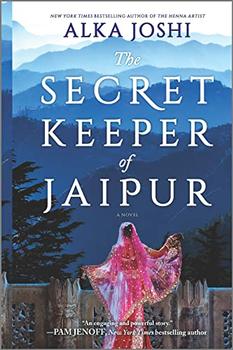Summary | Excerpt | Reading Guide | Reviews | Beyond the Book | Read-Alikes | Genres & Themes | Author Bio

The Jaipur Trilogy #2
by Alka JoshiThis article relates to The Secret Keeper of Jaipur
 Alka Joshi's novel The Secret Keeper of Jaipur takes place in the city of Jaipur, the capital of the Indian state of Rajasthan and home to over three million people.
Alka Joshi's novel The Secret Keeper of Jaipur takes place in the city of Jaipur, the capital of the Indian state of Rajasthan and home to over three million people.
Founded in 1727 by Maharaja Jai Singh II, Jaipur is said to be the first completely planned city in India. The Maharaja became aware that his current capital, Amber (now named Amer, about seven miles northwest of Jaipur) could no longer support the growing population, and so he decided to build a new city to serve as the seat of his government. Following the principles of Shilpa Shastras (ancient Indian sciences of design), he worked with renowned Bengali scholar Vidyadhar Bhattacharya to meticulously plan the city's layout, including parks, canals and market areas; construction took around four years. Jaipur was designed along a grid with nine designated blocks, two of which were for governmental buildings and palaces, with the other seven reserved for residential use. Huge walls (approximately 20 feet tall and 10 feet thick) were erected to provide security and punctuated by seven massive gates, or "pols," by which people entered or exited the enclosed city.
Jaipur has been nicknamed the "Pink City" because many of its buildings are, indeed, a pastel pink. King Sawai Ram Singh had it painted that color (traditionally the color of welcome or hospitality) to honor the 1876 visit from British royal Prince Albert, the Prince of Wales (later King Edward VII). Since then, all government buildings and royal palaces have retained their pink hue and new buildings are painted to match, thereby continuing the custom.
The area is replete with architectural marvels, perhaps the best known of which is the Hawa Mahal, or "Palace of the Winds." Built as a palace extension in 1799, the five-story structure was designed to resemble the crown of the Hindu god Krishna. Most of its 953 windows are relatively small, and were constructed to allow the women of the royal household to view the outside world without being seen themselves. The upper three levels were dedicated to the worship of Krishna. Interestingly, there are no stairs to these floors, only ramps, built to accommodate the palanquins (litters) of the royal women. Other well-known structures include the ancient Amber Fort; Nahargarh Fort ("An Abode to Tigers"); the Jal Mahal ("Water Palace"), situated in the middle of Sagar Lake and once used as a hunting lodge by royalty; and the City Palace, home to the Royal Family of Jaipur.
Needless to say, Jaipur's magnificent architecture makes it a popular tourist attraction, with around 52 million visitors in 2019 — most of them traveling from elsewhere in India. It's considered part of the "Golden Triangle" — a popular 450-mile sightseeing loop that consists of Jaipur, India's capital city Delhi and Agra, site of the Taj Mahal — and is consistently ranked among the top tourist destinations in Asia. UNESCO designated the Pink City a World Heritage Site in 2019.
While tourism is the area's primary economic driver, Jaipur is also known for its craft industry, particularly its production of jewelry. It's a major exporter of gemstones, especially amethyst, emerald, garnet and topaz. The city also hosts a rapidly growing technology industry, providing software development, maintenance and support services.
Hawa Mahal (Palace of the Winds) in Jaipur, 2015. Photo by Anuja.desai (CC BY-SA 4.0)
Filed under Places, Cultures & Identities
![]() This "beyond the book article" relates to The Secret Keeper of Jaipur. It originally ran in September 2021 and has been updated for the
June 2022 paperback edition.
Go to magazine.
This "beyond the book article" relates to The Secret Keeper of Jaipur. It originally ran in September 2021 and has been updated for the
June 2022 paperback edition.
Go to magazine.
Knowledge is of two kinds. We know a subject ourselves, or we know where we can find information on it.
Click Here to find out who said this, as well as discovering other famous literary quotes!
Your guide toexceptional books
BookBrowse seeks out and recommends the best in contemporary fiction and nonfiction—books that not only engage and entertain but also deepen our understanding of ourselves and the world around us.